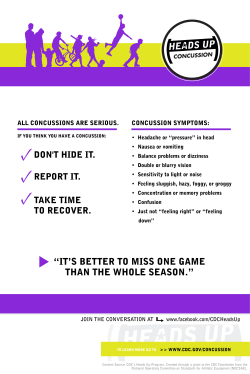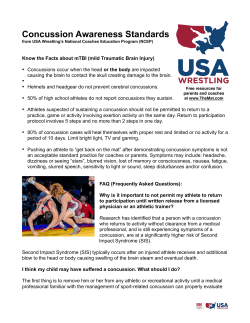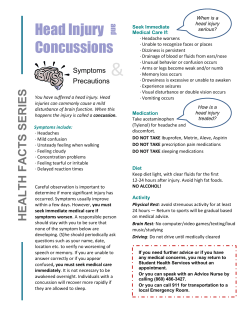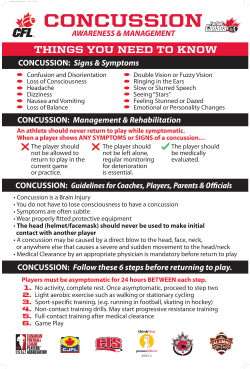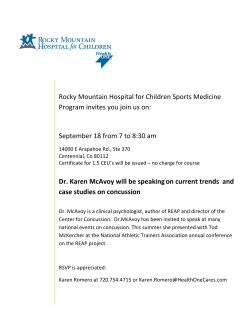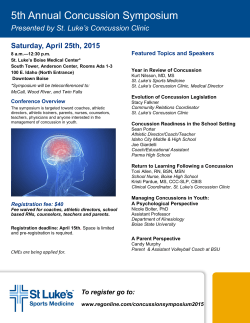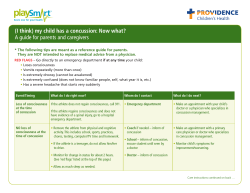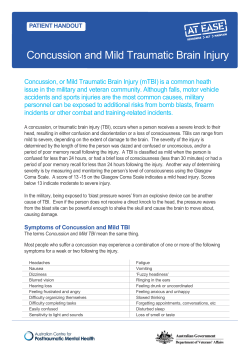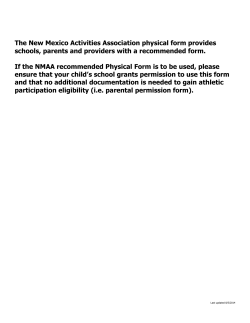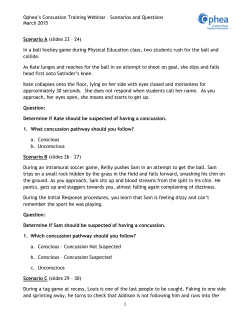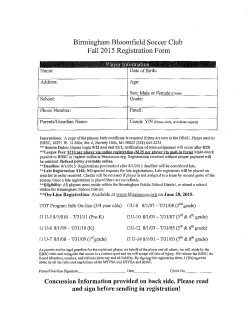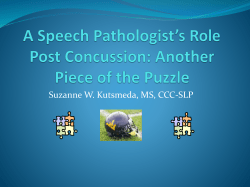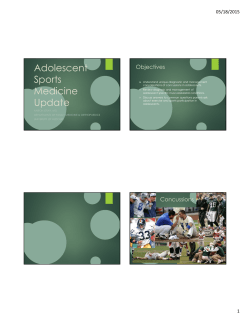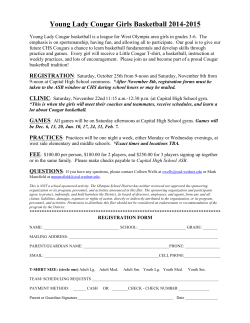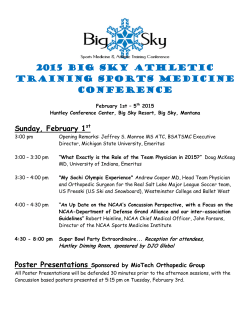
Concussion in Sports ACSM Information On…
ACSM Information On… Concussion in Sports A concussion is an injury to the brain where force causes the brain to move within the skull. A person does not need to lose consciousness or have hit their head to suffer a concussion. All athletes and non-athletes, regardless of age, who are suspected of a concussion must stop playing in practice or competition immediately. A COMPLETE PHYSICAL ACTIVITY PROGRAM A well-rounded physical activity program includes aerobic exercise and strength training exercise, but not necessarily in the same session. This blend helps maintain or improve cardiorespiratory and muscular fitness and overall health and function. Regular physical activity will provide more health benefits than sporadic, high intensity workouts, so choose exercises you are likely to enjoy and that you can incorporate into your schedule. ACSM’s physical activity recommendations for healthy adults, updated in 2011, recommend at least 30 minutes of moderate-intensity physical activity (working hard enough to break a sweat, but still able to carry on a conversation) five days per week, or 20 minutes of more vigorous activity three days per week. Combinations of moderate- and vigorousintensity activity can be performed to meet this recommendation. Examples of typical aerobic exercises are: • Walking • Running • Stair climbing • Cycling • Rowing • Cross country skiing • Swimming. In addition, strength training should be performed a minimum of two days each week, with 8-12 repetitions of 8-10 different exercises that target all major muscle groups. This type of training can be accomplished using body weight, resistance bands, free weights, medicine balls or weight machines. WHAT IS A CONCUSSION? A concussion is an injury to the brain caused by a sudden acceleration or deceleration force, and concussions occur in many different sports. While an athlete does not need to hit his or her head to suffer a concussion, hits to the head— against another person, a ball, or the ground—are a common cause. The brain moves inside the skull, and the sudden movement can cause the brain to swell. Helmets protect against more serious head injuries, but they do not necessarily prevent concussions. It may not be obvious to parents, coaches, trainers and athletes immediately how bad the head injury is, so if a concussion is at all suspected, the athlete needs to stop with the practice or the game. SYMPTOMS OF CONCUSSION The most serious concussion symptoms could be associated with a more severe head injury, such as bleeding into the brain. People with the following “red flag” symptoms need emergency care: • Increasing confusion or headaches; • Vomiting, double vision or unequal pupils; • Irritability or behavior change; and • Drowsiness or fading in and out of consciousness. STAYING ACTIVE PAYS OFF! Those who are physically active tend to live longer, healthier lives. Research shows that moderate physical activity – such as 30 minutes a day of brisk walking – significantly contributes to longevity. Even a person with risk factors like high blood pressure, diabetes or even a smoking habit can gain real benefits from incorporating regular physical activity into their daily life. As many dieters have found, exercise can help you stay on a diet and lose weight. What’s more – regular exercise can help lower blood pressure, control blood sugar, improve cholesterol levels and build stronger, denser bones. Other concussion symptoms are less obvious and are split among four categories: • Physical symptoms—headache; nausea; dizziness; vision or balance problems; sensitivity to light or noise. • Cognitive symptoms—feeling mentally slow or foggy; trouble concentrating; trouble remembering. • Emotional symptoms—irritability; sadness; nervousness; feeling more emotional than usual. • Sleep-related symptoms—sleeping more or less than usual; drowsiness; trouble falling asleep. CONCUSSION DIAGNOSIS Assuming the injured athlete does not have any of the most serious symptoms, he or she will not need a head CT scan or MRI. There is currently no imaging test that can diagnose a concussion. The doctor will ask about symptoms, complete a neurological physical exam and possibly balance testing, and may opt to perform mental agility testing known as neuropsychological testing. These tests are best if there is a pre-injury baseline for comparison, and this may be a service offered by your local school, club or hospital. CONCUSSION TREATMENT Unfortunately, people with a concussion usually look and act normally, so it is difficult for them and their family, teachers and coaches to tell they’ve suffered a concussion. Like any other injured body part, the concussed brain should be rested in order to recover. During recovery, athletes should have no physical exertion that will raise the heart rate, and they should also perform no mental work, such as school or other tasks, that require concentration. Doctors commonly prescribe periods of reduced schoolwork and tests after a concussion, but they may need to start with complete brain rest, including no thinking, texting or video games. As the brain recovers, cognitive activity can be gradually returned. Only when the brain is working normally at rest, with no recurrence of the symptoms listed above, is the athlete ready to return to play. Most people with concussions recover in 7-14 days. Some individuals require significantly longer times, and some are never quite back to normal. Repeated concussions can be associated with more severe injury and longer recovery. A repeated concussion before the brain is fully recovered can be fatal, causing rapid brain swelling and second impact syndrome. RETURNING TO PLAY A progression of return-to-play after a concussion begins only after all symptoms have cleared at rest and with mental exertion. Then an athlete can begin a fiveday gradual return, stopping and waiting at any point when exertion causes symptoms to return. • Day 1: Low-level activity, such as walking or slow jogging. • Day 2: Increased intensity of jogging, running or biking. • Day 3: Heavy non-contact activity, including sprinting. • Day 4: Contact activity in controlled practice situation. • Day 5: Full participation. THE FIRST STEP Before you begin an exercise program, take a fitness test, or substantially increase your level of activity, make sure to answer the following questions. This physical activity readiness questionnaire (PAR-Q) will help determine if you’re ready to begin an exercise routine or program. • Has your doctor ever said that you have a heart condition or that you should participate in physical activity only as recommended by a doctor? • Do you feel pain in your chest during physical activity? • In the past month, have you had chest pain when you were not doing physical activity? • Do you lose your balance from dizziness? Do you ever lose consciousness? • Do you have a bone or joint problem that could be made worse by a change in your physical activity? • Is your doctor currently prescribing drugs for your blood pressure or a heart condition? • Do you know of any reason you should not participate in physical activity? If you answered yes to one or more questions, if you are over 40 years of age and have recently been inactive, or if you are concerned about your health, consult a physician before taking a fitness test or substantially increasing your physical activity. If you answered no to each question, then it’s likely that you can safely begin exercising. PRIOR TO EXERCISE Prior to beginning any exercise program, including the activities depicted in this brochure, individuals should seek medical evaluation and clearance to engage in activity. Not all exercise programs are suitable for everyone, and some programs may result in injury. Activities should be carried out at a pace that is comfortable for the user. Users should discontinue participation in any exercise activity that causes pain or discomfort. In such event, medical consultation should be immediately obtained. ACSM grants permission to reproduce this brochure if it is reproduced in its entirety without alteration. The text may be reproduced in another publication if it is used in its entirety without alteration and the following statement is added: Reprinted with permission of the American College of Sports Medicine. Copyright © 2011 American College of Sports Medicine. This brochure was created by Kristine Karlson, M.D. It is a product of ACSM’s Consumer Information Committee. Visit ACSM online at www.acsm.org.
© Copyright 2025
